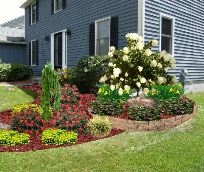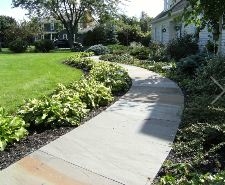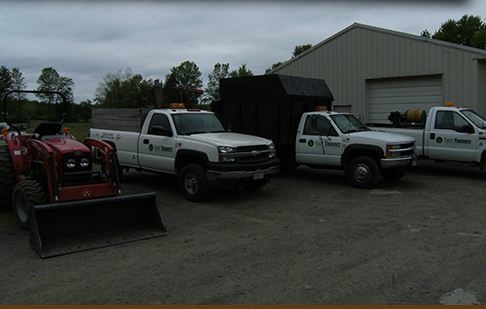Did you know that since ancient times, stones have played an important role in Japanese culture and symbolism? In modern Japanese landscape design, large stones symbolize mountains and hills, while smaller rocks and gravel are used to represent water.
Use well-defined pathways to suggest a sense of order in wild and low maintenance areas of your yard. Paths make it clear to visitors how they should journey through your gardens, preventing accidental damage to shrubs, flowers, and other plantings.
If you are considering selling your property any time soon, it is vital to keep it looking as good as possible. Curb appeal for a home includes not only the outside of the structure itself but the lawn and garden. A landscape expert can ensure your landscaping always looks its best.
In order to be effective, fertilizer must be applied in the proper amounts at the proper times during the season. This will depend on many factors, including your soil type, the needs of the particular plant, and the condition of the current soil.
In the late Heian period in Japanese history (around 1185 CE), there was a strong attraction to the ideal of the Buddhist or Pure Land paradise. Thus, gardens of this period were built to resemble that paradise, featuring a large pond with lotus flowers and islands, as well as beautiful pavilion buildings.
Do you have the time required to handle the landscaping duties for your property? Between work, school, and a host of personal obligations it can be difficult to find any free time, much less time to maintain the yard. Instead, rely on an expert and use that time for your family or elsewhere.
Japanese gardens first appeared on the island of Honshu, Japan. Their aesthetics were influenced by the diverse characteristics of the Honshu landscape: mountain streams with waterfalls and cascades, rugged volcanic peaks, lakes, narrow valleys, and beaches of small stones.
In the spring, it’s recommended that you have any garden beds top dressed with compost or well-seasoned manure to prepare them for planting. The beds should not be dug up, as they have a complex soil ecosystem that is best left undisturbed.
Care to guess in which century Japanese gardening techniques began appearing in Western gardens? Interest in Japanese gardening principles first developed in Europe during the 1800s, and it's a trend that continues today in some of the world's most spectacular gardens.
In an organically managed lawn, you may want to consider leaving clover as a desirable species, rather than labeling it a weed. Clover is a "nitrogen-fixer," meaning it can convert nitrogen in the atmosphere into a useable form that will provide nutrients for your lawn.
While a severe slope to your yard can make it difficult to figure out the garden, it can also create a unique opportunity. If you’re interested in creating various levels in your garden, the use of retaining walls is an absolute must.
While thatch buildup is a problem, thatch is necessary for the healthy growth of your lawn, and constant dethatching can be harmful. Once your lawn is dethatched, spread a new layer of compatible topsoil on your lawn to smooth out inconsistencies, and stimulate the growth of beneficial organisms to introduce nutrients.
The materials that are used for professional lawn applications are of a very low toxicity and are registered and used in strict compliance to labeled instructions. They are applied by licensed technicians in accordance with state and local regulations.
Did you know that a professionally landscaped workplace increases worker productivity? In fact, many psychologists agree that people experience a greater sense of restfulness and peace, which translates to higher functioning and greater work output.
If you think your grass is growing too darned fast to keep up with, you may be right. Some grass varieties can grow 2.5 inches a week during the summer season. Yikes.
Remember that in Japanese gardens, the emphasis is on foliage rather than flowers, although you can add a few flowering plants to punctuate the seasons. Use lighter shades against darker shades while mixing fine and bold textures. Limit your choice of plants and let your mantra be: Less is more!
While you may be a savant at getting the results you want in your garden, some varieties of grass can be trickier. Let’s talk about the problems your lawn is dealing with and whether we can help you alleviate them.
Cleaning up your landscape after a bad storm may mean a lot of things. If it’s a serious problem, a landscape contractor may be able to help with replacing your plants and even repairing walls that may have been damaged.
One way to help avoid problems with ants, termites, mosquitoes, rats, mice, and bats is to maintain a clean landscape. A tidy, airy garden provides less cover and fewer feeding opportunities for garden pests.
The vibrant colors of fall are infinitely inspiring. As the aptly named poet John Greenleaf Whittier wrote, “The tints of autumn … [are] a mighty flower garden blossoming under the spell of the enchanter, frost.”
Organic lawn care can actually help in the photosynthesis process for your lawn. In fact, organic lawn manure releases carbon dioxide, which will help boost photosynthesis and result in a much healthier lawn.
When choosing plants for a Japanese-style garden, it is important to combine Asian natives with indigenous specimens. Your landscaper will adapt the style to your local climate and location to allow your garden to really thrive.
Traditional Japanese gardens use plants as symbols of moving thoughts. In fact, these universal forms of life can also express joy or sorrow, pleasure or pain. Plants used in Japanese gardens are manifestations of communion between life and nature.
Did you know that nitrogen is considered to be the most needed nutrient for plant growth, as it is an essential building block for assembling amino acids, nucleic acids, and protein? Plants that are deficient in nitrogen tend to be smaller, yellow, and less productive.








